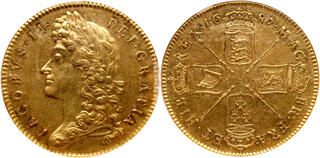| Ira & Larry Goldberg Coins & Collectibles > Auction 137 | Auction date: 29 January 2024 |
| Lot number: 1125 Price realized: 55,000 USD (Approx. 50,941 EUR) Note: Prices do not include buyer's fees. | Show similar lots on CoinArchives Find similar lots in upcoming auctions on |
| Lot description: Great Britain. Five Guineas, 1687. S.3397A; Fr-292. James II, 1685-1688. Second laureate bust. King facing left. Reverse; Crowned cruciform shields. An unusually well struck and lustrous specimen. Pop 2; 1 in 60; 1 in 61. NGC graded AU-58. Estimated Value $20,000 - UP ** All James II coins are rare and as this was a very short (four years) series the reign is numismatically popular. King James II was a complex but rather unexciting character who lived much of his life in the shadow of his more charismatic brother, King Charles II. When their father was facing defeat by the Parliamentary forces during the English Civil War, James escaped from St James's Palace in 1648 and left the country. He married Anne Hyde, daughter of Edward Hyde (later Duke of Clarendon) at The Hague, Netherlands, in August 1659, and returned to England when the monarchy was restored in 1660. Like his brother, he had a string of mistresses - Jane Middleton, Elizabeth Butler Lady Chesterfield, Goditha Price, Margaret Brook Lady Denham, Arabella Churchill, and Catherine Sedley Countess of Dorchester, among others, and a string of illegitimate children! James converted to Catholicism in the 1660's, but his brother Charles II, fearful of upsetting public opinion, insisted that he should still take the Anglican connunion and that his surviving (legitimate) children (the future monarchs Mary II and Anne) should continue to be instructed as Protestants. Things were fine until James's wife Anne died in 1671 and in 1673 married the 15 year old Mary of Modena. In 1685 Charles II died and James became King. In 1688 his new Roman Catholic wife, Mary, bore him a Catholic son, and James asked the Pope to stand as godfather! This was a step too far for an English public which was heavily Protestant. At this stage, a group of English magnates - six moneyed lords and a bishop - asked William of Orange, James's son-in-law, to deliver the nation from 'a perpetuation of evil'. William landed in Torbay and James, with his army, advanced to meet him. When James's generals deserted him he fled to Ireland, where he was defeated by William at the Battle of the Boyne in July 1690, and he spent his last years in France. In the meantime, William and Mary assumed the throne as joint monarchs. Ex Goldberg Sale 34, Feb 5, 2006, lot 2243. |  |


